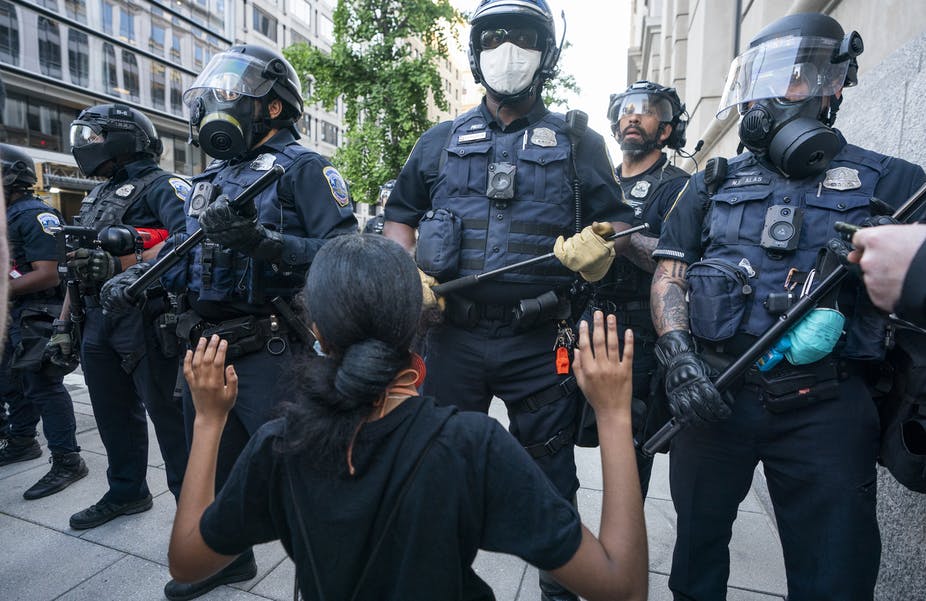George Floyd protests show how the US has retreated from its position as a world leader

A majority of Americans believe their country is going in the wrong direction (Jim Lo Scalzo/EPA)
By Inderjeet Parmar*
The killing of George Floyd at the hands of the Minneapolis police has sparked a furious response from all sections of American society. One poll showed that 55% of Americans believe police violence against the public is a major problem, while 58% support the view that racism is one of today’s biggest problems. Another poll showed two-thirds of Americans believe their country is heading in the wrong direction.
The US has been brought to this point by a long-term legitimacy crisis of the American elite, accompanied by rising levels of mass discontent and coercive state responses. The Floyd killing appears to be the spark that lit the fuse. The protests are fuelled by anger at other recent deaths of minorities from police brutality, and at the disproportionate effects of the coronavirus pandemic on African-Americans.
At the same time, America’s global image as world leader has further diminished as it adopts increasingly coercive attitudes to allies, competitors, rivals and international institutions, to protect its positions in the face of greater competition. This is a long-term shift that President Donald Trump’s “America First” approach has systematically intensified to previously unseen heights.
The European Union, using language normally reserved for undemocratic states, expressed grave concerns over Floyd’s killing and police response. It hoped “all the issues” related to the protests in the US “will be settled swiftly and in full respect for the rule of law and human rights”.
In the broadest sense, at home and internationally, the US is moving towards coercion and the exercise of hard power, and away from its previous strategies based on soft power and international leadership.
Racism and foreign policy
America, the land of the ethno-racial melting pot, is once again facing what the Swedish economist Gunnar Myrdal optimistically called The American Dilemma in 1944. He explained this as the chasm between white American’s apparently deeply-held creed of equality – a fundamental attachment to democracy, freedom, equality and humanity as defining core values – and the country’s glaring levels of racial inequality.
In truth, Myrdal and his philanthropic sponsors at the Carnegie Corporation were imbued with the ideology of white supremacy and sought to find ways to preserve it on a global scale. In their view, the future of African-Americans lay in assimilation into white culture because black culture was pathological.
Yet, there was also US elite recognition, in the context of the anti-Nazi second world war, that scientific racism and American racial segregation were politically untenable. This was reinforced by the needs of wartime production and the imperatives of US-Soviet cold war competition to recruit allies at the UN from among newly independent, post-colonial states.
The position was clear: for the US to lead the world, not just the west, it had to deal with its domestic racial inequalities, or at least their most visible manifestations. This created permissive space for key Supreme Court decisions such as Brown vs Board of Education, which ended state-sanctioned racial segregation in schools. The permissive environment also helped create favourable conditions for the civil rights movement of the 1950s and 1960s.
To be a world leader after 1945, the US had to be seen to be anti-racist. The world was watching to see what kind of culture the fledgling American superpower really was.
From Obama to Trump
Aspirations for a post-racial America soared with the election of President Barack Obama in 2008. America’s moral authority, so severely dented by the Iraq War, seemed to have been rescued.
But the longed-for post-racial society was exposed as a myth even before the end of Obama’s first term. Obama, known among pollsters as a moderate “no-demands black”, had largely circumvented issues of structural racism in a sea of soaring rhetoric about the American dream.
Despite two terms of office, poverty and inequality in general and especially for African-Americans increased to levels greater than prior to Obama’s election, as did police violence. Numerous deaths of African-Americans occurred at the hands of the police during his presidency, leading to major uprisings including in Ferguson, Missouri, in 2014.
And it was in the wake of Obama’s electoral victories that Trump, who questioned the president’s very identity as an American, cut his political teeth as a leader of the “birther” movement, and won the 2016 presidential election on a platform of (white) America First.
The whole world is watching
American media has long projected its news and culture to a fascinated global audience. And the world has been watching as Trump tries to remake American identity along even starker racial lines. Trump harnessed growing anxieties among white, mainly Republican, voters, about an emerging non-white majority in the US population, predicted by demographers to occur around 2044.
In foreign policy, Trump has controversially challenged, undermined and begun coercing or withdrawing from key institutions of the liberal international rules-based order. The US under Trump has stepped back from multilateral cooperation, and “soft power”, and adopted a coercive and transactional approach to foreign policy steeped in America First nationalism. In doing so, it has retreated from its position as a world leader.
A world view based around ideas of western and white superiority is embedded in the Trump administration at home and abroad. It is evident in its policies regarding immigrants, refugees and asylum seekers, and attitudes towards China. The immigrant is frequently portrayed as a disease-carrier, the coronavirus is “Chinese”, and China is a “non-Caucasian” challenger to US and western power.
This trend has been confirmed by the fourth resurrection of the infamously hawkish Committee on the Present Danger, a group of national security experts, think tank members and former military staff, some with links to the far right. This time its sole focus is on China, and it is headed by Trump’s former chief strategist, Stephen Bannon.
As Trump’s America seeks neither global approval nor cross-party electoral appeal, it no longer worries so much about who is watching. Coercion is trumping leadership at home and abroad.
* Inderjeet Parmar is professor of international politics at City, University of London, a visiting professor at LSE IDEAS (the LSE’s foreign policy think tank), and visiting fellow at the Rothermere American Institute at the University of Oxford. He is a columnist at The Wire and a member of the advisory board of INCT-INEU (Brazil’s National Institute of Science and Technology for Studies on the United States).
** Originally published at The Conversation, June 5, 2020.





















